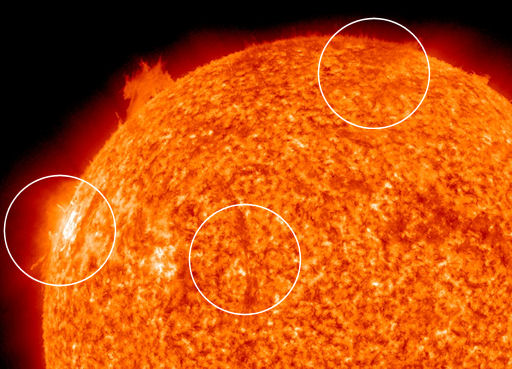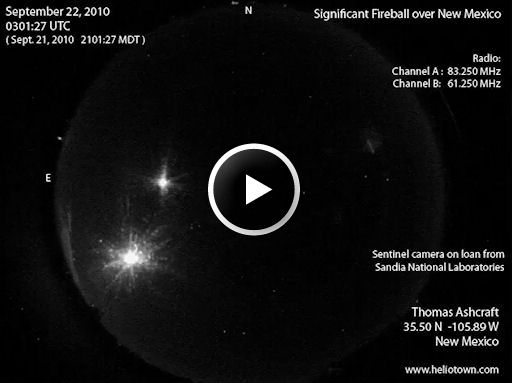iPHONE VS ANDROID! Actually, it doesn't matter which phone you carry. Our cool, new app turns both smartphones into field-tested satellite trackers. Learn more. | | |
WATCH OUT FOR THE SUPER HARVEST MOON: For the first time in almost 20 years, northern autumn is beginning on the night of a full Moon. The coincidence sets the stage for a "Super Harvest Moon" and a must-see sky show to mark the change of seasons. Get the full story from Science@NASA.
GLOBAL ERUPTION: This morning between 0230 UT and 0600 UT, the northern hemisphere of the sun erupted in a tumult of activity. At least two dark magnetic filaments became unstable and lifted off the stellar surface, a B8-class solar flare flashed from sunspot 1109, and a bright coronal mass ejection billowed into space (SOHO movie). Click on the image to play a time-lapse movie from Solar Dynamics Observatory--and pay attention to the circled regions:

The eruption is reminiscent of the global event of August 1st, which hurled a CME toward Earth and sparked Northern Lights in the United States as far south as Iowa. This time, however, the CME will miss Earth (unless it veers off course) so there should be no resulting geostorms.
Stay tuned for more movies of this event.
SOUTHWESTERN FIREBALL: Last night (Sept. 21st) around 09:01 pm MDT, a dazzling fireball glided across the skies of New Mexico and west Texas. "We’ve been getting a lot of calls in the newsroom about an object – maybe a meteorite – falling from the sky," says Peter St. Cyr of KOAT TV in Albuquerque. An all-sky camera outside Santa Fe caught the object in flight. Click on the image to launch a 5 MB movie:

Note: In the movie, the stationary light is the full Moon, the moving light is the fireball.
"It took 23 seconds to cross the sky and was nearly as bright as the full Moon," says Thomas Ashcraft, who operates the camera. "The fireball made a sonic boom loud enough to be heard inside above fan noise and household din. At first I thought it was thunder."
After passing over New Mexico, the fireball apparently continued on to Texas. "At 10:05 pm CDT, my wife and I witnessed a slow moving fireball coming from the west," reports Matthew Byrd of Amarillo. And then a second fireball appeared: "About 7 or 8 min later we saw another fireball moving in the same direction directly over Amarillo. It was bright white and shedding white sparks."
US Space Command reports no satellites or pieces of space junk decaying at the time of the sightings. This was probably a random meteoroid--and maybe two--disintegrating in Earth's atmosphere.
Sept. 2010 Northern Lights Gallery
[previous Septembers: 2009, 2008, 2007, 2006, 2005, 2004, 2002, 2001, 2000]
Potentially Hazardous Asteroids (
PHAs) are space rocks larger than approximately 100m that can come closer to Earth than 0.05 AU. None of the known PHAs is on a collision course with our planet, although astronomers are finding
new ones all the time.
On September 22, 2010 there were 1145 potentially hazardous asteroids.
Notes: LD means "Lunar Distance." 1 LD = 384,401 km, the distance between Earth and the Moon. 1 LD also equals 0.00256 AU. MAG is the visual magnitude of the asteroid on the date of closest approach. | | The official U.S. government space weather bureau |
| | The first place to look for information about sundogs, pillars, rainbows and related phenomena. |
| | Researchers call it a "Hubble for the sun." SDO is the most advanced solar observatory ever. |
| | 3D views of the sun from NASA's Solar and Terrestrial Relations Observatory |
| | Realtime and archival images of the Sun from SOHO. |
| | from the NOAA Space Environment Center |
| | from the National Solar Data Analysis Center |

